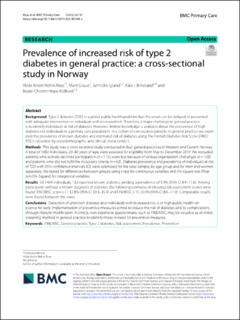| dc.contributor.author | Riise, Hilde Kristin Refvik | |
| dc.contributor.author | Graue, Marit | |
| dc.contributor.author | Igland, Jannicke | |
| dc.contributor.author | Birkeland, Kåre Inge | |
| dc.contributor.author | Kolltveit, Beate-Christin Hope | |
| dc.date.accessioned | 2024-02-01T14:12:57Z | |
| dc.date.available | 2024-02-01T14:12:57Z | |
| dc.date.created | 2023-08-22T08:28:16Z | |
| dc.date.issued | 2023 | |
| dc.identifier.issn | 2731-4553 | |
| dc.identifier.uri | https://hdl.handle.net/11250/3115107 | |
| dc.description.abstract | Background
Type 2 diabetes (T2D) is a global public health problem, but the onset can be delayed or prevented with adequate intervention in individuals with increased risk. Therefore, a major challenge in general practice is to identify individuals at risk of diabetes. However, limited knowledge is available about the prevalence of high diabetes risk individuals in a primary care population. In a cohort of consecutive patients in general practice we examined the prevalence of known diabetes and estimated risk of diabetes using The Finnish Diabetes Risk Score (FINDRISC) calculator, by sociodemographic and clinical characteristics.
Methods
This study was a cross-sectional study conducted in four general practices in Western and Eastern Norway. A total of 1682 individuals, 20–80 years of age, were assessed for eligibility from May to December 2019. We excluded patients who actively declined participation (n = 112), were lost because of various organization challenges (n = 103) and patients who did not fulfil the inclusions criteria (n = 63). Diabetes prevalence and prevalence of individuals at risk of T2D with 95% confidence intervals (CI) were estimated for the total sample, by age group and for men and women separately. We tested for differences between groups using t-test for continuous variables and chi-square test (Pearson Chi-Square) for categorical variables.
Results
Of 1404 individuals, 132 reported known diabetes, yielding a prevalence of 9.9% (95% CI 8.4–11.6). Among participants without a known diagnosis of diabetes, the following estimates of elevated risk assessment scores were found: FINDRISC score ≥ 11 32.8% (95% CI 30.3–35.4) and FINDRISC ≥ 15 10.0% (95% CI 8.6–11.9). Comparable results were found between the sexes.
Conclusions
Detection of unknown diabetes and individuals with increased risk, is of high public health relevance for early implementation of preventive measures aimed to reduce the risk of diabetes and its complications through lifestyle modification. A simple, non-expensive questionnaire, such as FINDRISC, may be valuable as an initial screening method in general practice to identify those in need for preventive measures. | en_US |
| dc.language.iso | eng | en_US |
| dc.publisher | BMC | en_US |
| dc.rights | Navngivelse 4.0 Internasjonal | * |
| dc.rights.uri | http://creativecommons.org/licenses/by/4.0/deed.no | * |
| dc.title | Prevalence of increased risk of type 2 diabetes in general practice: a cross-sectional study in Norway | en_US |
| dc.type | Journal article | en_US |
| dc.type | Peer reviewed | en_US |
| dc.description.version | publishedVersion | en_US |
| dc.rights.holder | Copyright 2023 The Author(s) | en_US |
| dc.source.articlenumber | 151 | en_US |
| cristin.ispublished | true | |
| cristin.fulltext | original | |
| cristin.qualitycode | 1 | |
| dc.identifier.doi | 10.1186/s12875-023-02100-x | |
| dc.identifier.cristin | 2168596 | |
| dc.source.journal | BMC Primary Care | en_US |
| dc.identifier.citation | BMC Primary Care. 2023, 24, 151. | en_US |
| dc.source.volume | 24 | en_US |
| dc.source.issue | 1 | en_US |

